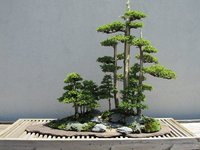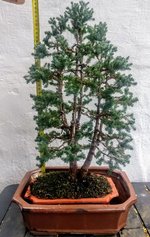You are using an out of date browser. It may not display this or other websites correctly.
You should upgrade or use an alternative browser.
You should upgrade or use an alternative browser.
Check your sense of scale
- Thread starter Fidur
- Start date
Aeast
Shohin
28"
Eckhoffw
Masterpiece
Based off the 2.5mm wire, I’ll say 45cm.
mwar15
Omono
14.77”
ShadyStump
Imperial Masterpiece
jimib
Shohin
304,973 micrometers
Lutonian
Chumono
I think about 8.5 inch and I think is is a chamaecyparis thyoides rubicon
Joe Dupre'
Omono
28"
rockm
Spuds Moyogi
You do set a scale when including a figure like an animal, pagoda, etc.I can see a monster standard deviation, wich allows me to say that when you submerge in a pic of a tree, with no scale refferences, you can imagine the scale that better fit your expectations, and it seems those can be different for different people....
I want to think, that when you introduce a scale refference in one tree (an animal for instance), you're setting a scale..
While that can be interesting and it's a standard part of Chinese penjing, such things are consciously excluded from Japanese bonsai.
Setting a firm scale for the tree, the thinking goes in Japanese bonsai, actually takes away from the tree's impact. The Japanese use empty negative space, in particular, to emphasize scale. Without a firm reference point, that scale depends on the viewer, allowing them to put themselves into the composition in their mind's eye, instead of being led their by the grower. Think "monster movie that doesn't show you the monster."
The Japanese use figures separate and outside the pot in displays--kusamono, okimono--tenpai. Those figures and wall scrolls don't have to be "in scale" with the tree and are aimed at setting an overall mood for the tree. Japanese bonsai is more about creating a feeling than actual physical replication of a place. Penjing can be about place and re-creating a specific place.
The Japanese esthetic is a different perspective. I find it more satisfying since it allows more room for the viewer's mind to roam.
Oh and the tree looks to me to be about 18" or so...
Maiden69
Masterpiece
28 1/8", I would say 28, but it is already stated... that's guessing that the thick wire is an 8ga, 22.5" if it is a 10ga.
rockm
Spuds Moyogi
Another thing that can bring perspective and scale to a planting is using foreshortening with the elements in it (if it's a planting with multiple elements. Experts who make compositions that use shorter and taller trees use this technique to "force" perspective. The shorter trees in the background appear to be further in the distance than those taller ones in the foreground. The planting below shows a mountain path into the distance. Shorter trees on the left are meant to be seen as farther away:
Attachments
sorce
Nonsense Rascal
I can see a monster standard deviation, wich allows me to say that when you submerge in a pic of a tree, with no scale refferences, you can imagine the scale that better fit your expectations, and it seems those can be different for different people....
I want to think, that when you introduce a scale refference in one tree (an animal for instance), you're setting a scale..
Setting a firm scale WITH AN EXTERNAL OBJECT, for the tree, the thinking goes in Japanese bonsai, actually takes away from the tree's impact. The Japanese use empty negative space, in particular, to emphasize scale.
Is it fair to add that assumed position? CAPS
Just seems slightly misleading without it, since the use of negative space is used to emphasize scale.
I think then it may be the definition of "firm" that is "fuzzy" in the conversation.
I believe a "firm" scale IS set by the proportions of the tree. Beginning with the roots, as usually this is the first thing we approach in nature.
I feel this thread is dangerously close to pushing folks away from this reality that SCALE IS ALWAYS AND ALWAYS HIGHLY IMPACTFUL.
I feel there is an odd disconnect in understanding the relationship between scale and height....
As this quickly became a height guessing game that has absolutely nothing to do with scale.
Crop the roots back into picture, everything changes, it's likely just a shrub again. Nothing elegant, nothing stately.
This is to say that roots, as I've been ranting about as of late, are almost always entirely too large. Once that's gone, scale is never correct.
I would like to know everyone idea of the height of that tree IN SCALE....
25ft? 100ft? 200ft?
Perhaps we do not have very good understanding of such heights? Not many references?
I know I may have a few more references of heights due to measuring these things in building, and I still have a hard time guessing the height of a tree.
I think this is something that needs excersize, understanding the relationship between height and scale.
Sorce
penumbra
Imperial Masterpiece
So when, pray tell, will the mystery be revealed?
Fidur
Chumono
I Will be attaching a pic with the measures in 15 minutes, so post your guesses asap .....
Fidur
Chumono
HorseloverFat
Squarepants with Conkers
NOICE!
Lutonian
Chumono
ha ha I was miles off
rockm
Spuds Moyogi
"Oh and the tree looks to me to be about 18" or so..."Here we go.....
View attachment 408854
Measure is in cm. I would say 46 cm - 18,11 inches...... who was closest? (My own guess was 50 cm)
Mayank
Chumono
Did that not work because it didn't have scale foliage?I tried using foliage length for a second but wasn't able to scale it that well
Similar threads
- Replies
- 3
- Views
- 332
- Replies
- 0
- Views
- 358



